In Greek it has the word "scolios", which translates as "crooked".With this word, doctors indicate the bending of the spinal column.Moreover, not all bending, namely the lateral deviation of the vertical axis of the spine.The fact is that normally our spine is not perfectly.Bends available at the front and back (lordosa and kyfosis) protect the spine from excess loads while keeping the body in a certain position when moving and carrying weights.Negative processes in our bodies develop only when these kyphosis and lordosis are expressed more than the permitted rate.
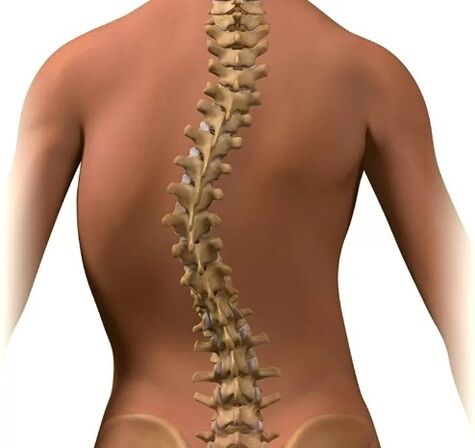
Main problems
However, even a small degree of side curves (scoliosis) of the spine is always a pathology.And the issue is not just in a cosmetic defect.Although a characteristic repulsive appearance with pronounced or progressive scoliosis is always a tragedy for a person seeking to live a full quality life.This is especially true for young boys and girls.Indeed, it is in the period of children and youth (up to 15 - 16 years) that is diagnosed an important part of scoliosis.
The main problem is that due to a change in configuration and volume of chest with pronounced side curvature, internal organs always suffer (heart, lungs, stomach, liver, intestine, large vessels).In men, tolerance to physical exercise decreases, women have problems with conception, maintaining pregnancy and childbirth.Moreover, very often the side deformation of the spine is only the superficial part of the iceberg, which is a sign of much more serious pathology - tumor, tuberculosis, endocrine disorders.
Reason
Then why is the spine deformed?Before answering the question, you must decide on the types of scoliosis.At its core, scoliosis can be structural and unpructor.Structural scoliosis develops due to anatomical changes in the structure of the bone tissue of the vertebrae, as well as the muscles, nerves and ligamentous apparatus located nearby.Such curves can be obtained and congenital, and about a quarter of all diagnosed scoliosis accounts for the latter.
Among the main reasons for the development of structural scoliosis, they distinguish:
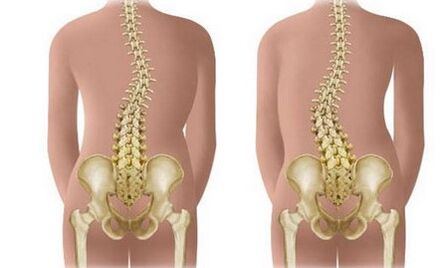
- Intrauterine development masts leading to dysplastic disorders of one or more vertebrae
- Congenital chest development abnormalities - absence of ribs, extra ribs
- Congenital connective tissue pathology - neurofibromatosis, Marfan syndrome
- Brain failure due to children's cerebral palsy (cerebral palsy), leading to a violation of certain parts of the spine
- Osteoporosis (bone -tissue) of the spine in the rickets, diseases of the parathyroid glands, lack of calcium intake with food
- Vertebrate osteomyelitis
- Dystrophic changes in the cervical, chest and lumbar muscles
- Damage to tuberculosis in the beads
- Spinal cord
- Spine tumors.
Non -structural scoliosis, as follows from the name, are the lateral deviations of the spinal column with the unchanged structure of the vertebrae.As a rule, such scoliosis is most often obtained unless bending is a compensatory nature with congenital anatomical defects of the pelvis or lower extremities.The causes of such scoliosis are most often:
- Pelvic injuries and lower extremities
- Congenital pelvic defects and lower extremities
- Continuous improper behavior in school students
- Diseases of the internal organs with asymmetrically expressed pain syndrome
- Inflammation of the muscles (myosite)
- Burns, sores of soft fabrics on one side.
In these cases, to eliminate the curvature of the spine, it is sufficient to cure the underlying disease, and therefore many non -computational scoliosis are easily reversible.In this regard, some doctors tend not to calculate non -structural deformities for scoliosis in general.
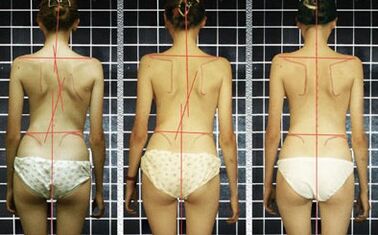
Recently, cases of scoliosis development with unclear causes have become more frequent.This is the so -called idiopathic scoliosis.Occurs in the years of youth, during the period of rapid body growth.Moreover, girls suffer from idiopathic scoliosis several times more often than young men.Apparently, this is due to the relatively weak muscles of the back of the female, which is unable to close the spine in a full muscle frame.An unbalanced diet with low calcium salts and a general passion for young people with carbonated drinks plays an not last role in the development of idiopathic scoliosis.As you know, carbon dioxide in bubbles and orthophosphoric acid in synthetic inclusions contribute to the flow of calcium salts from the body.
Varieties and degrees
Depending on the localization, scoliosis can be cervix, chest, lumbar or mixed (cervix, lumbosacral).It is possible to have one or more bending arches.In this regard, C (1 bow), S -shaped scoliosis (with 2 arches) and Z (with 3 arches) are distinguished.Most likely, the presence of 2 or 3 arches is compensatory.With C -shaped scoliosis, the axis of the spinal column deviates.In an effort to compensate for this, the spine bends in the opposite direction.In this regard, scoliosis is divided into compensation and uncompensated.In the offset spine, a vertical line seated from the 7th cervical vertebra passes through the folding between the buttocks.
The curvature of the spine often combines.For example, in the chest region, in addition to the side bending, pathological kyphosis is marked, or simply a lump.In these cases, talking about the chest of the chest.In addition, with large scoliosis scales, in addition to the lateral displacement of the vertebrae, the thuria is marked.In a genuine translation, it means twist.Indeed, with a lot of scoliosis, the vertebral bone tissue is twisted along the vertical axis.
Depending on the size of the bending arch angle, 4 degrees scoliosis are distinguished:
- 1st degree- The bending angle does not exceed 10 degrees.Asymmetry with eyes is practically not determined.Attraction, the uneven level of the shoulder band, pays attention.
- 2 stairs- The bending angle is from 11 to 25 degrees.To this extent, the beads have already been observed.There is an asymmetry of the shoulder band and pelvis that is visible in the eye.Due to the pathological tension of the muscles, a muscular scroll is formed in the middle region, and in the chest area-with a convex.
- 3 degrees- Wrtification is from 26 to 50 degrees.Visible chest deformity - west of intercostal spaces C on the concave side of bending and convex swelling.Weakening of the abdominal press, the formation of an inner hub.
- 4 degrees- The bending angle exceeds 50 degrees.A cosmetic defect and all previous signs are expressed.Low tolerance and even small physical exercise.In addition to the skeletal muscular system, the internal organs suffer.
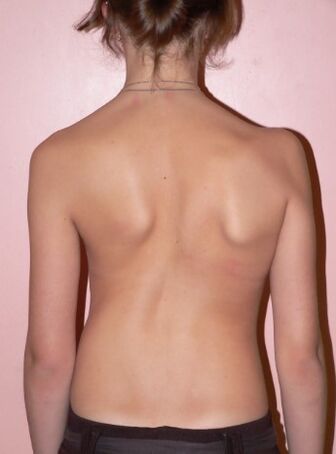
The angle may vary depending on the position of the body, while stable and unstable scoliosis is distinguished.With unstable scoliosis, it decreases in the lie position when the load on the spinal column decreases.With a steady curvature of the spine, this value remains unchanged.
Symptoms
Recently, orthopedists often use the term "scoliotic disease".And they show a complex of adverse changes that occur in the body during the curvature of the spine.As a rule, scoliotic disease develops in childhood and adolescence during the formation of the muscular system.At this time, there is a high probability that scoliosis progresses.
Apparently, the intervertebral discs play an important role in increasing the bending angle.With a lateral displacement, the disk experiences uneven pressure from vertebral bodies.On the concave side, this pressure is greater, with a convex - less.As a result, the disk creates even more from scoliosis, a pathological muscle tension (muscle roller) creates and rotation of the vertebrae - all this leads to the appearance of disc herniation and further increase in the bending angle.
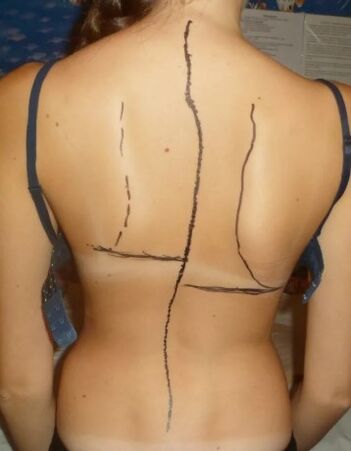
Along with the spine with a scoliotic disease, the chest changes the second.A lump of so -called ribs is formed - on the convex side of bending, the intercostal spaces are expanded, and by concave - on the contrary, they are planted.With the 4th degree scoliosis, the chest deformation is so pronounced that the lower ribs on the bending side are in contact with the iliac bone canal.
Due to severe chest deformity, a complete excursion during breathing is difficult.As a result, the body with severe scoliosis does not receive the required amount of oxygen - the so -called chronic hypoxia develops with a violation of all metabolic processes in the body.The pathology is exacerbated by the fact that the inner volume and shape of the chest cavity vary.Because of this, the blood flow to the vessel is disturbed, the lungs suffer, the heart shape develops, the chronic cardiovascular failure develops.
Similar changes occur in the abdominal organs for lumbar and lumbosacral scoliosis.Stomach and intestinal motorcycles decrease with subsequent enzymatic insufficiency of the digestive glands.All this only exacerbates metabolic disorders.These violations often lead to the late sexual maturity of boys and girls.In addition, due to lumbar scoliosis, the pelvis is curved for the second time.This creates problems for future mothers with gestation and childbirth.
Troubleshooting
The diagnosis of scoliosis, especially large ranks, as a rule, is not difficult.To detect the deformation of the spine, a common visual examination is often sufficient.The visible curvature of the spine contours, the asymmetry of the shoulder girdle, shoulder blade angles, secondary pelvic curvature, and shortening of the lower limbs on the bending side are visible.
In the presence of at least one of these signs, the radiography of the spinal column is indicated.X -Ray determines the configuration, scale and localization of bending.During inspection and radiological examination, it is possible to determine whether the scoliosis is offset and stable.Recently, a new qualitative method of magnetic spinal resonance research (MRI) has spread, during which a three-dimensional image of the spine can be obtained on the monitor screen.With considerable curvature, it is necessary to investigate the work of the internal organs - to perform a spirometry, electrocardiography and perform an ultrasound of the heart and internal organs.
Treatment
Treatment of scoliosis can be performed both conservatively and immediately.Conservative methods include medication treatment, massage, physiotherapeutic procedures and manual therapy.It should be borne in mind that the final formation of the spine ends up to the age of 20, and after this age, curvature correction is almost impossible.With 1-2 degrees scoliosis, efforts are aimed at achieving the initial, normal spine configuration.With pronounced scoliosis of the 3rd degree, this is inaccessible, the main thing here is to stabilize the spine and prevent the progression of scoliosis.

Medications (chondroprotectors, vitamins, general strengthening medicines) in the treatment of scoliosis play only one auxiliary role.To strengthen the muscles, eliminate the muscle roller, and even to a large extent to stabilize the spine with the help of massage and manual therapy.A good effect is given by physiotherapy exercises.But here, with insufficient physical exercise, spine instability has improved and scoliosis progresses.Therefore, a set of exercises develops for each patient individually, taking into account the localization and severity of bending.With a large degree of scoliosis, jogging, strength exercises, jumps, outdoor games are contraindicated.
A very good result gives the position correction - the optimal position that contributes to normalization of behavior is created.For this, special equipment is used, orthopedic cribs in which young patients spend a considerable part of their time.With the ineffectiveness of conservative masses, curvature progress, surgical treatment aimed at stabilizing the spine.Surgical correction is not indicated in early childhood, it is performed in adolescence, when the formation of the spine is almost finished.
















































